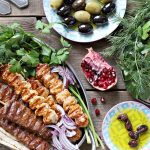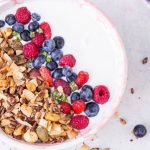
Easy, Healthy Diabetic Meal Plans
7-Day Diabetic Meal Plan
Understand what to include and eliminate in your diet when managing diabetes with our 7-day easy to follow diabetic meal plan!
Diabetes is a chronic health condition that currently affects more than one in four Canadians (including those with prediabetes). Unfortunately, it is a long-lasting condition that needs to be continually managed in order to prevent serious complications such as heart disease, kidney disease, foot and leg problems, eye and nerve damage and more from occurring. The good news is that with the right diet and lifestyle changes, it is possible to reduce the risk of these complications.
If you are reading this article, it is likely that you or someone you know is living with diabetes or prediabetes. We hope that you will find the tools you need in this article to create a diet plan that can help manage either of these conditions. For more resources, visit https://www.diabetes.ca/ and speak with your primary health care provider about how you can best manage you or your loved one’s specific health conditions.
Disclaimer: The information in this article is not intended to replace personalized medical advice. A low carb diet may not be suitable for you. Consult your health care provider before making any changes to your lifestyle or use this information at your own risk.
Understanding Diabetes
There are three types of diabetes: type 1 diabetes, also known as juvenile diabetes or insulin dependent diabetes; type 2 diabetes, also known as adult-onset diabetes; and gestational diabetes, which occurs during pregnancy. In addition, prediabetes, the set of conditions that precedes the onset of type 2 diabetes is an important consideration as it can also carry significant health risks.
Our focus in this article is helping those with type 2 diabetes and prediabetes, as these conditions make up 90% of Canadian diabetes diagnoses. In addition, both of these conditions are highly related to diet and lifestyle factors, making them easier to reverse and/or control.
Insulin: The Hormone Behind It All
If you have type 2 diabetes or prediabetes, your body is unable to produce or use the hormone, insulin, properly. Insulin helps regulate blood sugar levels and promotes the metabolism of carbohydrates. When we consume carbohydrates, they are broken down into glucose molecules which enter the bloodstream so they can be used as an immediate energy source by our cells or stored in the liver, muscles and fat tissue for later. This is where insulin steps in; it allows for glucose to leave the bloodstream and be used in one of these ways.
If the body does not produce enough insulin, excess sugar (glucose) will remain in the bloodstream, resulting in high blood sugar levels. High blood sugar can be very dangerous as it can cause serious damage to our cells, especially in the kidneys, the nerves in the hands and feet, and the eyes.
The alternative scenario is when the body can produce enough insulin, but the cells in our muscles, fat and liver do not respond well to it and cannot take up the excess glucose circulating in the bloodstream. This is known as insulin resistance, and it can increase over time if blood sugar levels remain consistently high, creating a vicious cycle.
The Takeaway
The takeaway from all of this, is that if your body does not produce enough insulin or use it effectively, as in the case of diabetes, it is important to take steps to manage your own blood sugar levels by making the right dietary choices. The goal is to keep blood sugar levels balanced throughout the day and this can be done by consuming nutritious foods in moderate amounts and eating at regular mealtimes. It can also help to make other lifestyle changes such as increasing daily activity levels (exercise makes our cells and muscles more sensitive to insulin) and losing weight if you are overweight.
Dietary Approaches to Treating Diabetes
When it comes to type 2 diabetes and prediabetes, food really is medicine. While your doctor can prescribe you with medications that lower insulin levels or reduce insulin resistance, these are not complete solutions. At the end of the day, if you are overweight or do not take care of your health through diet and exercise, the same complications that you face from diabetes are still going to linger.
While there is no specific “diabetes diet”, there are general dietary considerations for those with diabetes. These include:
1. Increase Your Fibre Intake.
Fibre helps to slow the absorption of sugar into the bloodstream, which can promote balanced blood sugar levels after meals. It also promotes healthy digestion in general, which can keep you feeling light, energized and satiated for longer periods to prevent excessive snacking. Plus, foods that are high in fibre (such as fruits and vegetables) offer many other health benefits due to their high nutrient content. Some high fibre foods include:
- Non-starchy vegetables: starches digest very quickly and therefore cause spikes in blood sugar levels. Aim to include non-starchy vegetables such as salad greens, broccoli, cabbage, cauliflower, carrots, celery, cucumbers, eggplants, mushrooms, bell peppers, radishes, onions, sprouts, peas, zucchini and spaghetti squash in at least 2/3 of your daily meals.
- Whole fruits: contrary to popular belief, fruits can be consumed by those with diabetes! Although they contain higher sugar levels than vegetables, their fibre content helps slow the absorption of these sugars into the bloodstream. Note that fruit juices should be avoided, since the fibrous parts of the fruits are often removed (yes, even in the case of orange juice with pulp). Some great fruits to include in your diet are berries, cherries, citrus fruits, peaches, apricots, apples, pears, and kiwis. Certain dried fruits are also good snacking options for diabetics, such as dried dates, apricots and raisins. These foods have a low glycemic index and are rich in fibre, vitamins and minerals.
- Whole grains: whole grains will always beat refined grains, which are often found in things like bread, pasta, and anything made with white flour (“enriched flours” are usually refined flours that have been fortified). Opt for whole grains, which have not been processed, which preserves their fibre content and nutritional value. These include things like oats, brown or wild rice, quinoa, buckwheat, wheat berries and whole wheat flour.
- Legumes: these are a great source of fibre and protein and they are some of the lowest glycemic index (GI) foods recommended to diabetics. Include legumes such as kidney beans, pinto beans, black beans, chickpeas (and hummus made from chickpeas), lentils, edamame (soybeans) and tofu, and peas in your diet regularly. These are also great substitutes for meat if you are interested in eating more vegan or vegetarian meals.
2. Cut Out Refined Carbs and Sweets.
While you don’t necessarily have to go low carb or keto if you have diabetes or prediabetes, it is nevertheless a good idea to cut out certain types of carbohydrates from your diet, namely refined carbohydrates. These are found in things like white bread, white pasta, white flour and many packaged chips, crackers, snacks and pastries. The problem with refined carbohydrates is that through the refining process, they lose a lot of their nutritional value which makes them rapidly digestible and prone to causing blood sugar spikes. For example, wheat that has been processed, milled and bleached contains a fraction of the fibre and nutrients found in whole grain wheat or even wheat berries, making it a much less forgiving food for diabetics (or anyone, for that matter!).
Sugar is also clearly something to minimize in your diet if you have been diagnosed with diabetes or prediabetes. Replace white sugar, brown sugar, cane sugar, and processed sugars (high fructose corn syrup, sucrose, glucose, dextrose, maltodextrin, etc.) with a natural sugar substitute such as stevia, erythritol, xylitol or monk fruit extract. Coconut palm sugar is another all-natural unrefined option that has a low glycemic index; however, it should be used with caution as it contains the same amount of calories and carbohydrates as regular sugar.
In general, it is easy to avoid refined carbohydrates and sweets if you stick to a whole foods diet approach. This means cooking and consuming foods that are minimally processed or not processed at all. A good rule of thumb when shopping at the grocery store is to stick to the peripheries: this is where you will find the produce, meat and dairy sections which should mainly contain single-ingredient foods. Bulk aisles are also a great place to find whole grains, nuts and dried legumes. The middle aisles of grocery stores often contain all of the processed packaged foods. If you are shopping here, make sure to always check nutrition labels and ensure that you can identify most if not all of the ingredients listed.
3. Eat Balanced Meals and Appropriate Portions.
Try to include a source of fibre, protein, and fat at every meal. This will not only ensure that your meals digest well, but you will also feel more satiated after a balanced meal since more of your nutritional needs will have been met. If you have ever felt peckish after having a full meal, it is likely you were missing sufficient amounts of one or more of these macronutrients.
In addition, be mindful of portion sizes. If you are trying to lose weight, you may want to consider consuming fewer calories. In order for the body to lose weight, the number of calories you consume must be fewer than those naturally burned by the body plus any additional calories burned through exercise.
4. Choose the Right Kinds of Fats and Cooking Oils.
Fats, especially the right kinds of fats, are an essential consideration for diabetics. “Good” fats promote heart health, while the wrong kinds can exacerbate heart conditions associated with diabetes. So, what are the right kinds of fats? Monounsaturated and polyunsaturated fats are the most beneficial because they can help lower cholesterol and triglyceride levels and reduce inflammation. These kinds of fats are found in plant-based foods such as olive oil, avocados, nuts such as almonds, cashews, and pecans and seeds such as pumpkin, sunflower, flax and sesame seeds. Unrefined coconut oil is also a good source of cholesterol-lowering saturated fats and has a high smoke point, making it ideal for cooking at high temperatures. To learn more about the best cooking oils check out our article, The Top 5 Cooking Oils: Cooking Oils Showdown. Finally, 1-2 servings of fatty fish (wild caught salmon, mackerel, sardines, etc.) per week provides sufficient amounts of omega-3 fatty acids (DHA and EPA) that can improve heart and brain health.
7-Day Diabetic Meal Plan
We’ve just thrown a lot of information at you, and you’re probably wondering where to start.
Below, you’ll find a sample of a 7-day meal plan that has been tailored for diabetics. This plan is a great way to start visualizing the changes to your diet. Of course, it won’t be a one-size-fits-all diet plan, and it is best to discuss your specific needs with your family doctor before making any major changes to your diet, especially if you are currently taking any medications for diabetes.
We have tried to include meal ideas that are simple to make and use many of the same ingredients throughout the week, so you don’t have go out and buy a ton of new grocery items or spend hours in the kitchen navigating complicated recipes. Simplicity is always key when starting out. If you don’t follow this diet plan exactly, it can at least provide some diabetic-friendly meal inspiration whenever you feel lost.
Click here to download a printable version of our 7-Day Diabetic Meal Plan.
| Breakfast | Lunch | Dinner | Snack/Dessert | |
| Monday | A bowl of oatmeal (1/2 cup of dry oats cooked with 1 cup water/milk/milk alternative and a dash of cinnamon) topped with nuts (almonds, walnuts, or pecans) or seeds (pumpkin seeds, chia seeds, hemp seeds or ground flax seeds) and fresh or frozen berries. | Bean and Quinoa Salad: 2-3 handfuls of leafy greens1 cup of cooked beans¼ cup of cooked quinoaTomatoesPeppers½ an avocadoDressing: extra virgin olive oil, lemon juice, salt, pepper, dried herbs (make extra to use all week) | Grilled sugar-free BBQ chicken served with brown rice and grilled asparagus brushed with garlic and olive oil. Make extra chicken to have as leftovers. | A handful of nuts, or a couple pieces of 70%+ dark chocolate. |
| Tuesday | Oatmeal with nuts/seeds and berries. | Grilled chicken Waldorf salad: 2-3 handfuls of leafy greensLeftover grilled chickenCelery ¼ of an apple, slicedRaisins½ an avocadoLeftover salad dressing | Vegetarian chilli served over brown rice or quinoa and topped with avocado slices. Chilli ingredients: 2 cans of diced tomatoes1 can of tomato paste2 cans of beans and/or chickpeas1-2 bell peppers, diced2-3 carrots, diced½ an onion, diced3-4 cloves of garlic, mincedSalt, pepper, garlic powder, onion powder, chili powder, cumin, crushed red pepper Add everything to a large stew pot and let simmer for at least 30 minutes. Make extra to have as leftovers. | Carrots and cucumbers with hummus |
| Wednesday | Omelette with mushrooms, bell peppers and spinach. Served with a piece of low carb bread and/or ½ an avocado. | Leftover chilli and brown rice/quinoa topped with avocado slices. | Grilled salmon with brown rice or quinoa and roasted vegetables: broccoli, cauliflower, carrots, and zucchini (or whichever vegetables you have on hand). Toss vegetables in olive oil, salt, pepper and garlic powder and roast at 320F for 45 minutes – 1 hour. Make extra roasted vegetables to have as leftovers. | Sliced apples or pears with 1-2 tablespoons of natural almond butter or peanut butter (beware of processed peanut butters as they often contain added sugars). |
| Thursday | Omelette with mushrooms, bell peppers and spinach. Served with a piece of low carb bread and/or ½ an avocado. | Roasted vegetable salad: 2-3 handfuls of leafy greensLeftover roasted vegetables1 cup of beans, cooked¼ cup of quinoa, cookedLeftover salad dressing | Tofu stir-fry (season with soy sauce, garlic, ginger and crushed red pepper) with carrots, peppers and broccoli served over brown rice. Make extra to have as leftovers. | A handful of nuts and 2-3 dried dates or 4-5 dried apricots. |
| Friday | Oatmeal with nuts/seeds and berries. | Leftover tofu stir-fry and brown rice. | Veggie burgers served on whole wheat or low carb buns and homemade sweet potato* fries (toss in coconut oil, add salt, pepper, and cayenne pepper to taste). *Sweet potatoes are high in fibre, vitamins and minerals and therefore safe for diabetics in moderate amounts. | A handful of nuts, or a couple pieces of 70%+ dark chocolate. |
| Saturday | Omelette with mushrooms, bell peppers and spinach. Served with a piece of low carb bread and/or ½ an avocado. | Veggie Patty Salad: 2-3 handfuls of leafy greensTomatoesPeppersRed onions1 veggie patty, cooked Primal Kitchen Ranch Dressing (or other ranch dressing, but check for added sugars) | Grilled salmon with brown rice and roasted vegetables: broccoli, cauliflower, carrots, and zucchini (or whichever vegetables you have on hand). Make extra roasted vegetables to have as leftovers. | 1-2 Low GI Banana Oatmeal Cookies (makes 8-10 cookies): 1 mashed overripe banana + 1 tablespoon of sweetener if desired1 cup of rolled or quick oats1 teaspoon of baking powder¼ cup of raisins or ¼ cup of sugar-free dark chocolate chips (or both!)CinnamonSalt Bake at 350F for about 15 minutes or until light brown and set. |
| Sunday | Protein pancakes (1 serving): ½ a mashed banana or 1 tablespoon of sweetener1 cup of almond, oat or whole wheat flour1 egg or 1 scoop of protein powder1 teaspoon of baking powderCinnamonPinch of salt Cook in a pan with coconut oil. | Roasted vegetable salad: 2-3 handfuls of leafy greensLeftover roasted vegetables1 cup of beans, cooked¼ cup of quinoa, cookedLeftover salad dressing | Grilled sugar-free BBQ chicken served with brown rice and grilled asparagus brushed with garlic and olive oil. Make extra chicken and rice to have as leftovers. | 1-2 Low GI Banana Oatmeal Cookies |
Connect with Us!
We hope that you enjoyed reading this article and feel motivated to make the necessary changes to your diet and lifestyle if you are managing type 2 diabetes or prediabetes. If you would like to share your thoughts or experiences with our online community, head over to our Facebook page.
We also love to read our reviews on Google, so if you enjoyed an experience you had with The Low Carb Grocery, please take a minute to let us know here! And, don’t forget to sign up for our Weekly Newsletters if you haven’t already to receive updates on our latest product launches and special sales.






